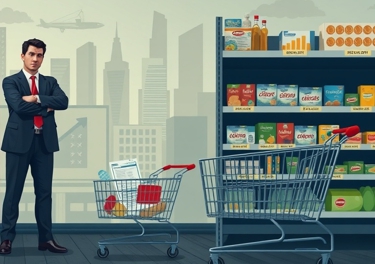1. What is stagflation?
Stagflation is a situation where the economy is not growing, but prices are still rising.
It combines two words — stagnation (slow or no growth) and inflation (rising prices).
Normally, when prices go up, the economy is doing well. But during stagflation, people suffer because jobs decrease while the cost of living increases.
스태그플레이션이란 무엇인가?
스태그플레이션(Stagflation)은 경제가 성장하지 않는데 물가만 오르는 상황을 말합니다.
이 단어는 stagnation(경기침체)과 inflation(물가상승)의 합성어입니다.
보통 물가가 오를 때는 경제도 활발하지만, 스태그플레이션 시기에는 일자리가 줄고 생활비는 올라 사람들이 어려움을 겪습니다.
stagflation 경기 침체 속의 물가 상승
stagnation 침체, 정체
inflation 물가 상승, 인플레이션
economy 경제

2. Why does stagflation happen?
Stagflation often happens when the cost of production rises sharply, such as when oil or raw material prices increase. Companies face higher expenses, so they raise prices, but consumers buy less because their purchasing power drops. This leads to slow growth and high prices at the same time. Poor government policy or excessive money printing can also make stagflation worse.
스태그플레이션이 발생하는 이유
스태그플레이션은 보통 생산비용이 급격히 상승할 때 발생합니다. 예를 들어, 석유나 원자재 가격이 오를 때 기업은 비용 부담 때문에 제품 가격을 인상합니다. 하지만 소비자들은 구매력이 떨어져 소비를 줄이게 되죠. 그 결과, 성장은 느려지고 물가는 오르는 현상이 동시에 나타납니다. 여기에 정부의 잘못된 정책이나 과도한 통화 발행도 상황을 악화시킬 수 있습니다.
cost of production: 생산비용
raw materials: 원자재
purchasing power: 구매력
excessive: 과도한
money printing: 통화 발행
3. What is inflation?
Inflation is the general increase in prices of goods and services over time.
When inflation occurs, the purchasing power of money decreases — in other words, the same amount of money buys fewer things than before.
A small amount of inflation is normal in a growing economy, but high inflation can make life expensive and cause economic problems.
인플레이션이란?
인플레이션(Inflation)은 시간이 지남에 따라 상품과 서비스의 전반적인 가격이 오르는 현상을 말합니다.
인플레이션이 일어나면 돈의 구매력(purchasing power)이 떨어집니다 — 즉, 같은 돈으로 살 수 있는 물건의 양이 줄어드는 것이죠.
적당한 인플레이션은 성장하는 경제에서 자연스러운 일이지만, 심한 인플레이션은 생활비를 높이고 경제를 불안하게 만듭니다.
4. How can we respond to stagflation?
There is no easy solution to stagflation because fighting inflation and boosting growth require opposite actions.
To control inflation, governments raise interest rates, but that can slow the economy even more.
To boost growth, they might lower rates or spend more money, but that could raise prices further.
Therefore, policymakers must balance these two goals carefully, focusing on productivity and stable energy supply.
스태그플레이션에 어떻게 대응해야 하나?
스태그플레이션은 대응하기가 매우 어렵습니다.
물가를 잡으려면 금리를 올려야 하지만, 그러면 경기가 더 나빠지고,
경기를 살리려면 금리를 내리거나 돈을 더 풀어야 하는데, 그러면 물가가 더 오릅니다.
그래서 정부는 두 가지 목표 사이에서 균형을 잡는 정책을 써야 하며,
생산성 향상과 안정적인 에너지 공급이 핵심 대응 전략이 됩니다.
raise interest rates: 금리를 인상하다
boost growth: 성장을 촉진하다
balance: 균형을 맞추다
productivity: 생산성
energy supply: 에너지 공급
5. Examples of stagflation in history
The most famous case of stagflation occurred in the 1970s, when oil prices skyrocketed after the OPEC oil crisis.
Many countries faced rising fuel costs, slow growth, and high unemployment.
스태그플레이션의 사례
가장 유명한 스태그플레이션 사례는 1970년대 석유파동(OPEC 오일쇼크) 때 발생했습니다.
당시 석유 가격이 급등하면서 많은 나라들이 연료비 상승, 경기 둔화, 실업 증가를 동시에 겪었습니다.
skyrocket: 급등하다
OPEC oil crisis: 석유파동
fuel costs: 연료비
stagflation
발음: /stæɡˈfleɪʃən/
뜻: 스태그플레이션, 경기 침체 속의 물가 상승
Stagflation means a situation in which the economy is not growing (stagnation), but prices are still going up (inflation).
스태그플레이션은 ‘경제가 침체되어 성장하지 않는데 물가만 오르는 현상’을 말합니다.
It is a mix of two words — stagnation + inflation.
So, stag (from stagnation) + flation (from inflation) = stagflation.
It describes an unhealthy economy:
단어는 stagnation(경기침체)과 inflation(물가상승)이 결합된 말이에요.
즉, 경기는 나쁜데 물가가 계속 오르는 경제의 병든 상태를 표현할 때 씁니다.
Prices are rising
Jobs are decreasing
People’s purchasing power is falling
The country is facing stagflation, with high prices and low employment.
그 나라는 물가 상승과 고용 감소가 동시에 나타나는 스태그플레이션을 겪고 있다.
During the 1970s, many nations suffered from severe stagflation caused by the oil crisis.
1970년대에는 석유 파동으로 인한 심각한 스태그플레이션을 겪은 나라가 많았다.
Stagflation is one of the hardest economic problems to solve.
스태그플레이션은 가장 해결하기 어려운 경제 문제 중 하나이다.
관련 어휘 (Related Vocabulary)
deflation 물가 하락, 디플레이션-- inflation의 반대
recession 경기 침체-- stagflation 시기에도 함께 나타남
purchasing power 구매력-- stagflation 시기에 감소함
economic slowdown 경기 둔화-- stagnation과 유사한 의미

























